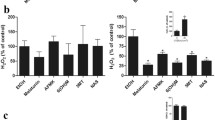Abstract
Human keratinocytes under in vitro conditions synthesize norepinephrine and epinephrine, whereas melanocytes lack this capacity. Keratinocytes established from lesional and nonlesional skin of patients with vitiligo synthesized four and two times more norepinephrine, respectively, than controls. Epinephrine synthesis was similar in keratinocytes from uninvolved epidermis and controls, but cells from involved skin had 6.5-fold less epinephrine than controls, indicative of low phenylehtanolamine-N-methyl transferase (PNMT) activity. Similar results were obtained in five patients with vitiligo who showed low epinephrine levels in involved epidermis. Both human keratinocytes and melanocytes expressed significant levels of monoamine oxidase A (MAO-A) activities as shown using14C-labelled 5-hydroxytryptamine as substrate and immunohistochemical staining with mouse monoclonal antibody. MAO-A activities in the total epidermis of patients with vitiligo were increased five- to ten-fold compared with skin of type-matched controls. Similar increases in MAO-A activities were also found in both keratinocytes and melanocytes established in vitro from vitiliginous epidermis. Based on these results, it can be concluded that defective catecholamine synthesis in the epidermis of patients with vitiligo leads to increased levels of norepinephrine with a concomitant increase in MAO-A activity.
Similar content being viewed by others
References
Aronoff S (1965) Catalase: kinetics of photo-oxidation Science 150:72–73
Bhawan J, Bhutani LK (1983) Keratinocyte damage in vitiligo. J Cutan Pathol 10:207–212
Dunerva SG (1973) Changes in the content of adrenaline and noradrenaline in the blood of patients with vitiligo. Vest Dermatol Venerol 10:33–36
Kalb VE Jr, Bernlohr RW (1977) A rapid method for protein determination. Anal Biochem 82:362–371
Kustala U (1968) A suction blister device for the separation of epidermis from dermis. J Invest Dermatol 50:129–137
LePoole C, Van den Wijngaard R, Smit NPM, Westerhof W, Pavel S (1991) On catechol-O-methyl transferase in vitiligo. Proceedings Third Meeting, European Society for Pigment Cell Research, Amsterdam, 66
LePoole C, Van den Wijngaard R, Smit NPM, Oosting J, Westerhof W, Pavel S (1994) Catechol-o-methyl transferase in vitiligo. Arch Dermatol Res 286:81–86
Lewinsohn R, Glover V, Sandler M (1980) Development of benzylamine oxidase and monoamine oxidase A and B in man. Biochem Pharamcol 29:1221–1230
Moellman G, Klein-Angerer S, Scollay DA, Nordlund JJ, Lerner A (1982) Extracellular granular material and degeneration of keratinocytes in the normally pigmented epidermis of patiens with vitiligo. J Invest Dermatol 79:321–330
Morrone A, Picardo M, DeLuca C, Terminali D, Passi S, Ippolito F (1992) Catecholamines and vitiligo. Pigment Cell Res 5:65–69
Pittelkow MR, Shipley GD (1989) Serum-free culture of normal human adult melanocytes: growth kinetics and growth factor requirements. J Cell Physiol 140:575–576
Schallreuter KU, Wood JM, Berger J (1991) Low catalase levels in the epidermis of patients with vitiligo. J Invest Dermatol 48:15–19
Schallreuter KU, Wood JM, Lemke R, LePoole C, Das P, Westerhof W, Pittelkow MR, Thody AJ (1992) Production of catecholamines in the human epidermis. Biochem Biophys Res Commun 189:72–78
Schallreuter KU, Wood JM, Pittelkow MR, Gütlich M, Lemke KR, Rödl W, Swanson NN, Hitzemann K, Ziegler I (1994) Regulation of melanin biosynthesis in the human epidermis by tetrahydrobiopterin. Science 263:1444–1446
Schallreuter KU, Wood JM, Ziegler I, Lemke KR, Pittelkow MR, Lindsey NJ, Gütlich M (1994) Defective tetrahydrobiopterin and catecholamine biosynthesis in the depigmentation disorder vitiligo. Biochim Biophys Acta 1226:181–192
Weicker H, Ferendi M, Haegele H, Pluto R (1984) Electrochemical detection of catecholamines in urine and plasma after separation with HPLC. Clin Chem Acta 141(1):178–185
Wille JJ, Pittelkow MR, Shipley GD, Scott RE (1984) Integrated control of growth and differentiation of normal human keratinocytes cultured in serum-free medium. Clonal analysis, growth kinetics and cell studies. J Cell Physiol 121:31–44
Yasuhara H, Parvez SH, Oguchi K, Sandler M, Nagatsu TL (1993) Monoamine oxidase: basic and clinical aspects. VSP, Utrecht Tokyo
Author information
Authors and Affiliations
Rights and permissions
About this article
Cite this article
Schallreuter, K.U., Wood, J.M., Pittelkow, M.R. et al. Increased monoamine oxidase A activity in the epidermis of patients with vitiligo. Arch Dermatol Res 288, 14–18 (1996). https://doi.org/10.1007/BF02505037
Received:
Issue Date:
DOI: https://doi.org/10.1007/BF02505037




